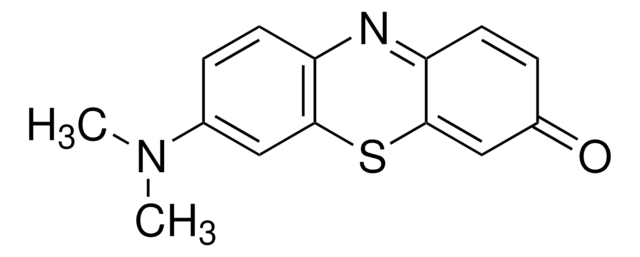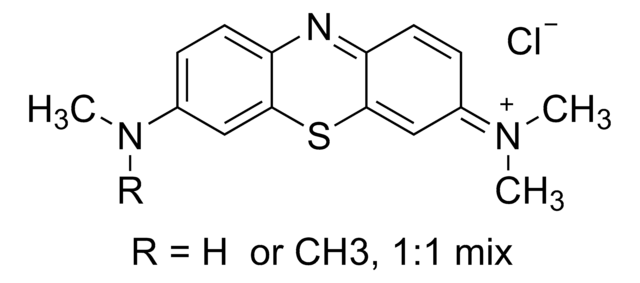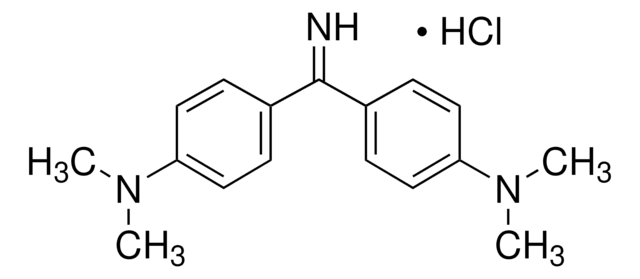861049
Azure A chloride
certified by the Biological Stain Commission, Dye content 70 %
Sinonimo/i:
Methylene blue
About This Item
Prodotti consigliati
Grado
certified by the Biological Stain Commission
Livello qualitativo
Forma fisica
powder
Composizione
Dye content, 70%
Colore
blue to very dark blue
very dark green
Punto di fusione
290 °C (dec.) (lit.)
Solubilità
H2O: 1 mg/mL
λmax
633 nm
ε (coefficiente d’estinzione)
≥11000 at 242-246 nm in H2O at -1
≥26000 at 287-291 nm in H2O
≥34000 at 620-634 μm in H2O
applicazioni
diagnostic assay manufacturing
hematology
histology
Temperatura di conservazione
room temp
Stringa SMILE
NC1=CC(SC(C2=N3)=CC(C=C2)=[N+](C)C)=C3C=C1.[Cl-]
InChI
1S/C14H13N3S.ClH/c1-17(2)10-4-6-12-14(8-10)18-13-7-9(15)3-5-11(13)16-12;/h3-8,15H,1-2H3;1H
NALREUIWICQLPS-UHFFFAOYSA-N
Cerchi prodotti simili? Visita Guida al confronto tra prodotti
Applicazioni
Azioni biochim/fisiol
Compatibilità
Codice della classe di stoccaggio
11 - Combustible Solids
Classe di pericolosità dell'acqua (WGK)
WGK 3
Punto d’infiammabilità (°F)
Not applicable
Punto d’infiammabilità (°C)
Not applicable
Dispositivi di protezione individuale
Eyeshields, Gloves, type N95 (US)
Certificati d'analisi (COA)
Cerca il Certificati d'analisi (COA) digitando il numero di lotto/batch corrispondente. I numeri di lotto o di batch sono stampati sull'etichetta dei prodotti dopo la parola ‘Lotto’ o ‘Batch’.
Possiedi già questo prodotto?
I documenti relativi ai prodotti acquistati recentemente sono disponibili nell’Archivio dei documenti.
Il team dei nostri ricercatori vanta grande esperienza in tutte le aree della ricerca quali Life Science, scienza dei materiali, sintesi chimica, cromatografia, discipline analitiche, ecc..
Contatta l'Assistenza Tecnica.




